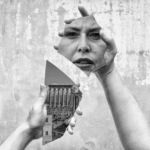There was no better time to be reminded of the history of Indigenous activism than on the day Australians were told they would be flocking to the polls to vote in Australia’s first referendum in 24 years.
And so last Wednesday I rolled up to the UTS First Nations Film Festival, with Anthony Albanese’s announcement of the date of the Voice to parliament vote still echoing in my thoughts.
Now, more than ever, we need to be watching and listening to First Nations stories such as these, about the fight for self-determination and sovereignty, to hear what they want and need. By revisiting the past, we can work towards improving our future.
We are reminded of both the anguish and spirit of our ancestors, those who walked this land before us and inspired us to enact change that will continue to propel our Indigenous peoples forward.
Constitutional change is something First Nations peoples have been fighting since before we were born and is something future generations will keep fighting for. For agency, self-determination, to be heard – for a Voice.
Over three short documentaries, the audience bore witness to the courage, strength and resilience of our First Nations peoples.
A Primer for Constitutional Reform (2018)
The evening began with A Primer for Constitutional Reform, directed by David Nixon, which took the audience on a journey through the history of Indigenous Rights activism by our First Nations peoples.
The timeline kicked off in 1846, with a petition – organised by Tasmanian Aboriginal people who had been exiled to Flinders Island – sent to Queen Victoria, regarding the promises made to them which had been broken. Black and white images of Indigenous families, communities and prominent figures interlaced with short videos gave the audience a short history lesson by effectively condensing almost 200 years of Indigenous Australian activism and the fight for constitutional reform into 30 minutes. We witnessed Indigenous rights organisations being built and dismantled within minutes, proposals rejected and pleas ignored, but despite this, their passion and resolve for self-determination has never ceased. Land is returned, agreements are reached and laws are passed – progress is made, albeit arguably not fast enough. It is at once infuriating and remarkable.
“Since 2008 we have had four prime ministers and six reports. Now a fifth committee is considering these reports,” the narrator states bleakly.
These final moments of the film are perhaps the most relevant they’ve ever been. Archie Roach’s We Won’t Cry plays while a slideshow of images from the Uluru Statement from the Heart convention is shown, a scene which almost felt incomplete given the current climate – I kept waiting to see images from the past couple of years, where the calls for a Voice to parliament were reignited, leading us to where we are now – a little under six weeks from voting at the referendum.
“When will it end? When will they hear us?”. These words have been echoing for years.
Fred Maynard: Aboriginal Patriot (2016)
In 1924, Aboriginal activist Fred Maynard founded the Australian Aboriginal Progressive Association (AAPA), the first large-scale Aboriginal rights movement, which aimed to improve the material conditions for Aboriginal people and end political oppression. They campaigned for Indigenous rights to citizenship and land ownership, to end the ‘Protectionist’ policies, and to have control over their own affairs.
The second film of the night Fred Maynard: Aboriginal Patriot, directed by Eualeyai and Gamillaroi woman Larissa Behrendt, saw the trailblazing activist’s grandson, historian and academic John Maynard, walk us through his grandfather’s life story – from his difficult childhood in Dungog, to the establishment of the AAPA, to his eventual tragic death.
One particularly harrowing scene juxtaposed a slow-motion reenactment shot of Fred and his brother running and playing whilst an excerpt from a speech by the Aboriginal Protection Board was heard. Other reenactment scenes saw the young girl Fred Maynard wrote a letter to, voicing his anger and sadness about her situation – that she had fallen pregnant after being raped by the owner of the home she was being indentured at. These distressing moments drove home the malice of the Protection Board and the importance of the AAPA in fighting against it.
John Maynard as the narrator offers a personal and heartfelt insight into his grandfather’s life, despite him passing away before he was born. Whilst at the stables where his father, renowned jockey Mervyn Maynard, frequented, he recounts how one day his father approached him to confess that they’d always believed that Fred’s death was no accident, contrary to what had been publicised. The political climate of the time, and the powerful actors that were against him, led his family and friends to believe that the Board wanted him silenced, once and for all.
John’s matter-of-fact delivery of this story creates a heart-wrenching air of inevitability, reinforcing the precarious and even dangerous position Indigenous activists were put in, simply for fighting for their people to be free.
Behrendt’s film does an extraordinary job of spotlighting an incredible Indigenous activist and his work for the Indigenous civil rights movement. Despite the dissolution of the AAPA in 1927, after a series of attempts by the Board and police to discredit him, Maynard and his organisation’s legacy is still seen in the ideas of successive generations of activists in NSW Indigenous communities.
Sisters in the Black Movement (2003)
Sisterhood. Unity. Passion. Sisters in the Black Movement pays a powerful homage to the unity, love and fierceness that women fight with.
Lou Glover’s 2003 documentary, produced by the festival’s curator Pauline Clague, daughter of Yaegl elder and prominent Indigenous activist Joyce Clague – who stars in this film alongside Faith Bandler, Mona Brand, Patricia Corowa, Theresa French, Jean Horner and Hazel Wilson – invites viewers to sit at the table as these six activist women rehash their experiences of being a part of the movement for the 1967 referendum, over a round-table lunch.
An incredible archive of footage accompanies the women’s stories, spanning from clips of fervent protests to gutting stills of families standing outside their makeshift homes on reserves. Each woman had a story that greatly contributed to the historic referendum, from protesting in the streets, to writing, to being actively involved in progressive organisations such as the Aboriginal-Australian Fellowship and the Federal Council for the Advancement of Aborigines and Torres Strait Islanders (FCAATSI).
Despite their experiences taking place some 30 years prior to the documentary being shot, it is clear their memories were as vibrant as ever, and that they held a lasting passion for both their friendships and the fight for Indigenous rights.
“We got to get that fire in that belly again,” Joyce Clague fiercely says towards the end of the film.
Sisters in the Black Movement is a beautiful example of what community, sisterhood and passion can achieve, and a reminder of the tenacity we should be fighting for in our current referendum.
Main image: screen at UTS First Nations Film Festival – Bianca Drummond Costa.




























